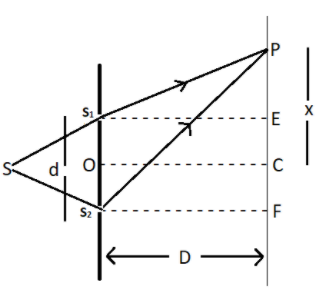Question
Question: To produce the interference fringe pattern, draw a diagram of Young’s double slit experiment. Derive...
To produce the interference fringe pattern, draw a diagram of Young’s double slit experiment. Derived an expression of fringe width for bright interference fringes. If the fringe width of bright fringes 2mm, write the fringe width for dark fringes. Whether the center point of interference fringe pattern is bright or dark? Explain it.
Solution
Hint: In this derivation for width of bright fringes in interference pattern first we will draw a diagram showing interference as shown and then we will proceed according to diagram with the help of Pythagoras Theorem and then for bright fringe make the path difference of light rays equal to integral multiple of wavelength of light and get the desired expression.
Formula Used: -
Pythagoras Theorem
H=P2+B2
Where H, Pand Bare the hypotenuse, perpendicular and base of the right angled triangle.
Given data: -
Let suppose a monochromatic light coming from source sand passes through slit s1 ands2 and meet at point P on screen which is at distance D from slits anddis the distance between slits.
PC=x, S1E=S2F=D,CF=EC=2d
PE=PC−EC=x−2d
PF=PC+CF=x+2d
Complete Step by step Solution:

In ΔS1PE using Pythagoras theorem
S1P2=S1E2+PE2
S1P2=D2+(x−2d)2…………………….. (1)
In ΔS2PF
S2P2=S2F2+PF2
S2P2=D2+(x+2d)2…………………….. (2)
On subtracting (2) from (1) we have
S2P2−S1P2=(x+2d)2−(x−2d)2=2xd
For bright fringes
Path difference S2P−S1P=nλ
where n=1,2,3,.....
And λ is a wavelength of monochromatic light.
Fringe width
The fringe width for bright fringes and dark fringes are same so if the width for bright fringes is 2mm
then it will be the same for dark fringes 2mm.
The center point of interference fringe pattern is bright.
Since there is no path difference of light rays coming from two slits reaching to the center point this will give the bright fringe at center point O.
Note: - In this question we should have the knowledge of the basic principle of interference and the condition for bright fringes and dark fringes. We use the Pythagoras Theorem carefully with the help of geometrical diagrams for the given situation.
